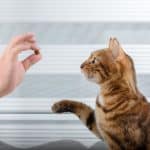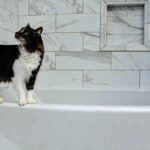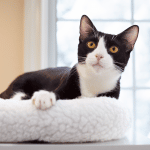Regarding cats, Georgina Strickland Gates is quoted as having said “Her function is to sit and be admired”. While that tinge of narcissism may be true about a cat’s personality and behavior, cats actually do more than just sit.
In order to express their feelings and emotions, cats use several key body parts to express themselves. If you want to learn more about what your cat is trying to tell you, then study his or her body language. Sure, they have vocal cords and use them to convey messages, but more often, a cat uses his body to tell you exactly what they’re thinking and feeling. Look at the following for clues to learn more about your cat:
The Tail
A cat’s tail tells tales (sorry – had to write that!) Seriously, a cat uses its tail to express many emotions and feelings. Here are just a few of the messages your cat is sending with its tail:
Upright tail – Your cat is happy to see you! Often called the “parade” tail, an upright tail is a friendly sign. If it is shaking back and forth just a little, your cat is really pleased to see you!
Halfway tail – A cat that holds its tail halfway up is saying that he’s not sure if his or her current situation is safe.
Submissive tail – Cats who tuck their tails between their legs are showing submission. Often cats will do this when they feel threatened or they have just been scolded.
Swishing tail – My cats use the swishing tail when they are irritated with my Border Collie that is trying to herd them. They may also swish their tails when they are interested in something (a moth, a bird outside, etc.)
Puffed up tail – Cats with puffed up tails (usually in the upright position) are showing either fear and/or aggression toward another cat or perceived threat.
The Eyes
Cats have an uncanny ability to show disdain, disapproval, happiness, eagerness and any other emotion through their eyes.
Fixed stare – The cat that has a fixed stare along with a stiff posture is usually showing anger, hostility or even anticipation in a good way. Look at your cat’s pupil size to determine if they want to be petted (large pupils) or are angry (tiny slits).
Eyelid opening – Cats with wide eyes are showing anticipation, alertness and an eagerness to do something (like play). When cats narrow their eyes they can be conveying anger or frustration. Also, if cats hold their eyes in kind of a sleepy, blinking stage, they are showing more relaxation and trust.
Head, Ears and Mouth
Cats will use their heads to show what they are feeling. For example, a cat with a lowered head and fixed eyes is usually upset with the object in his line of sight.
A cat that bumps it head into another cat is feeling friendly and comfortable. Cats will often lightly “head-butt” their owners as a sign of affection and greeting.
A cat’s ears rotate allowing him or her to capture many sounds. With 27 muscles controlling ear movement, cats can move their ears back and forth, one at a time, or up and down at will.
Flat ears indicate aggression. Upright ears are a sign of alertness. And ears that are pointing sideways may indicate that a cat is unsure of something going on around him or her.
Cats will use their vocal cords to express feelings. Hissing and snarling can send a pretty clear signal to a cat’s intended target. Kittens tend to communicate more with their vocal cords than do older cats that use their bodies.







